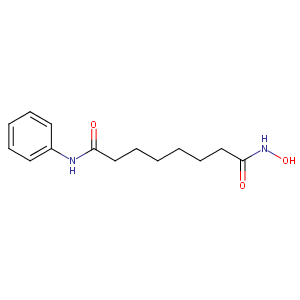Drug Information
| Drug General Information | Top | |||
|---|---|---|---|---|
| Drug ID |
D0E7PQ
|
|||
| Former ID |
DAP001082
|
|||
| Drug Name |
Vorinostat
|
|||
| Synonyms |
NHNPODA; SAHA; SHH; Zolinza; Merck brand of Vorinostat; OCTANEDIOIC ACID HYDROXYAMIDE PHENYLAMIDE; SAHA cpd; Suberanilohydroxamic acid; Suberoylanilide hydroxamic acid; Vorinostat MSD; Vorinostat [USAN]; M344; MK0683; SKI390; WIN64652; MK-0683; SAHA, Suberoylanilide hydroxamic acid; SW-064652; Zolinza (TN); Vorinostat (JAN/USAN); N1-hydroxy-N8-phenyloctanediamide; Zolinza, MK-0683, SAHA; N'-hydroxy-N-phenyloctanediamide; N-Hydroxy-N'-phenyl octanediamide; N-Hyrdroxy-N'-phenyloctanediamide; N-hydroxy-N'-phenyloctanediamide; N-hydroxy-N'-phenyl-octane-1,8-diotic acid diamide; Vorinostat (HDAC inhibitor)
Click to Show/Hide
|
|||
| Drug Type |
Small molecular drug
|
|||
| Indication | Cutaneous T-cell lymphoma [ICD-11: 2B01; ICD-10: C84.8; ICD-9: 202.1, 202.2] | Approved | [1], [2] | |
| Therapeutic Class |
Anticancer Agents
|
|||
| Company |
Merck
|
|||
| Structure |
 |
Download2D MOL |
||
| Formula |
C14H20N2O3
|
|||
| Canonical SMILES |
C1=CC=C(C=C1)NC(=O)CCCCCCC(=O)NO
|
|||
| InChI |
1S/C14H20N2O3/c17-13(15-12-8-4-3-5-9-12)10-6-1-2-7-11-14(18)16-19/h3-5,8-9,19H,1-2,6-7,10-11H2,(H,15,17)(H,16,18)
|
|||
| InChIKey |
WAEXFXRVDQXREF-UHFFFAOYSA-N
|
|||
| CAS Number |
CAS 149647-78-9
|
|||
| PubChem Compound ID | ||||
| PubChem Substance ID |
830547, 832844, 5620782, 7890463, 8153256, 12015019, 14710657, 14823867, 26684150, 29224365, 46393757, 46508989, 46519184, 47207977, 48426290, 49645508, 50070170, 50070537, 50071316, 50113029, 53788318, 56311712, 56312417, 56312644, 56314569, 57322702, 68530763, 75748492, 85736432, 87226482, 92708291, 92719823, 99350949, 99436957, 103174146, 104170365, 104171411, 104308873, 118048589, 121362164, 124756962, 124766849, 124795966, 124893441, 124893442, 125163768, 125335517, 126591282, 126628079, 126649066
|
|||
| ChEBI ID |
CHEBI:45716
|
|||
| ADReCS Drug ID | BADD_D02370 | |||
| SuperDrug ATC ID |
L01XX38
|
|||
| Interaction between the Drug and Microbe | Top | |||
|---|---|---|---|---|
| The Metabolism of Drug Affected by Studied Microbe(s) | ||||
| The Order in the Taxonomic Hierarchy of the following Microbe(s): Gut microbiota | ||||
| Studied Microbe: Gut microbiota unspecific | [3] | |||
| Metabolic Reaction | Nitroreduction | |||
| Experimental Method | High-throughput screening | |||
| Description | Vorinostat can be metabolized by gut microbiota through nitroreduction. | |||
| References | Top | |||
|---|---|---|---|---|
| REF 1 | URL: http://www.guidetopharmacology.org Nucleic Acids Res. 2015 Oct 12. pii: gkv1037. The IUPHAR/BPS Guide to PHARMACOLOGY in 2016: towards curated quantitative interactions between 1300 protein targets and 6000 ligands. (Ligand id: 6852). | |||
| REF 2 | Emerging therapies for multiple myeloma. Expert Opin Emerg Drugs. 2009 Mar;14(1):99-127. | |||
| REF 3 | Personalized Mapping of Drug Metabolism by the Human Gut Microbiome. Cell. 2020 Jun 25;181(7):1661-1679.e22. | |||
| REF 4 | Protein methyltransferases as a target class for drug discovery. Nat Rev Drug Discov. 2009 Sep;8(9):724-32. | |||
| REF 5 | Discovery of a potent class I selective ketone histone deacetylase inhibitor with antitumor activity in vivo and optimized pharmacokinetic properties. J Med Chem. 2009 Jun 11;52(11):3453-6. | |||
| REF 6 | Anticancer activities of histone deacetylase inhibitors. Nat Rev Drug Discov. 2006 Sep;5(9):769-84. | |||
If You Find Any Error in Data or Bug in Web Service, Please Kindly Report It to Dr. Zhou and Dr. Zhang.

